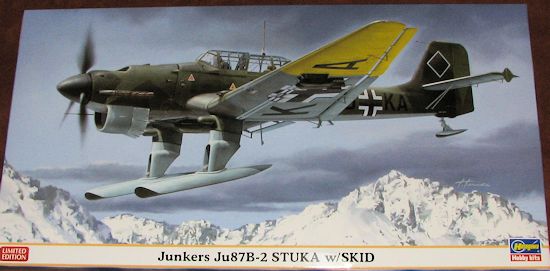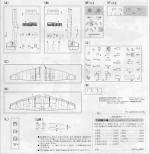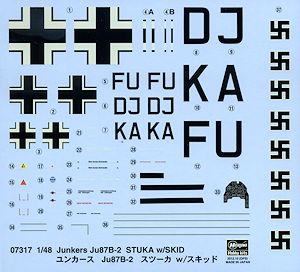
Hasegawa 1/48 Ju-87B-2 w/skid
| KIT #: | 07317 |
| PRICE: | $31.99 on sale (65.99 SRP) |
| DECALS: | Two options |
| REVIEWER: | Scott Van Aken |
| NOTES: | Includes resin parts. |

| HISTORY |
The Junkers Ju 87 or Stuka (from Sturzkampfflugzeug, "dive bomber") was a two-man (pilot and rear gunner) German dive bomber and ground-attack aircraft. Designed by Hermann Pohlmann, the Stuka first flew in 1935 and made its combat debut in 1936 as part of the Luftwaffe's Condor Legion during the Spanish Civil War.
The aircraft was easily recognisable by its inverted gull wings, fixed spatted undercarriage and its infamous Jericho-Trompete ("Jericho Trumpet") wailing siren, becoming the propaganda symbol of German air power and the blitzkrieg victories of 1939–1942. The Stuka's design included several innovative features, including automatic pull-up dive brakes under both wings to ensure that the aircraft recovered from its attack dive even if the pilot blacked out from the high acceleration.
Although sturdy, accurate, and very effective against ground targets, the Ju 87 was vulnerable to modern fighter aircraft, like many other dive bombers of the war. Its flaws became apparent during the Battle of Britain; poor manoeuvrability and a lack of both speed and defensive armament meant that the Stuka required heavy fighter escort to operate effectively.
The Stuka operated with further success after the Battle of Britain, and its potency as a precision ground-attack aircraft became valuable to German forces in the Balkans Campaign, the African and Mediterranean theaters and the early stages of the Eastern Front campaigns where Soviet fighter resistance was disorganised and in short supply.
Once the Luftwaffe had lost air superiority on all fronts, the Ju 87 once again became an easy target for enemy fighter aircraft. In spite of this, because there was no better replacement, the type continued to be produced until 1944. By the end of the conflict, the Stuka had been largely replaced by ground-attack versions of the Focke-Wulf Fw 190, but was still in use until the last days of the war. An estimated 6,500 Ju 87s of all versions were built between 1936 and August 1944
| THE KIT |
There is basically no difference in this kit and the previous Ju-87B. You have
all the bits there to do a standard Stuka should you so wish to do that. You get
a nicely detailed cockpit that includes the bomb aiming window in the floor in
front of the pilot. A well done gunner/radio operator's section is also part of
the fit. You are also supplied with a nicely done sidewall for the interior. The
most difficult part of my previous build was getting all the forward cowling
bits together, so take care when building this. This kit provides a prop
assembly with separate blades as those were in vogue during the design of this
kit.
Armament includes a large centerline bomb and four smaller bombs for the
wings. One needs to open holes for the dive brakes before assembling the wings.
The dive brakes should not be installed until after decals have been applied. As
mentioned, the new skids are molded in resin and are quite nice. The extensive
canopy is nicely molded and can be posed with the sliding portions open if one
so wishes.  This is one of the many 'special
boxing' kits that are so prevalent from Hasegawa. In this case, it is the
standard 1/48 Ju-87B kit with the inclusion of a set of resin skis.
Interestingly, this is not the first Hasegawa Ju-87B to include 'skids' (sic).
However, these are of a different design. The resin parts are very well molded
and should present no problems as they are simple replacements for the wheels.
In case you just can't make up your mind, the fit of the wheels on the one I
built many years ago was so tight that I didn't have to glue them in. You could
easily make them interchangeable.
This is one of the many 'special
boxing' kits that are so prevalent from Hasegawa. In this case, it is the
standard 1/48 Ju-87B kit with the inclusion of a set of resin skis.
Interestingly, this is not the first Hasegawa Ju-87B to include 'skids' (sic).
However, these are of a different design. The resin parts are very well molded
and should present no problems as they are simple replacements for the wheels.
In case you just can't make up your mind, the fit of the wheels on the one I
built many years ago was so tight that I didn't have to glue them in. You could
easily make them interchangeable.
 Instructions are well done with the usual Gunze paint references. There are
two markings options; both of them in the standard RLM 70/71/65 pattern typical
of Stukas. Apparently both have yellow lower wing tips. The only difference
between the two are the radio call numbers. One is DJ*KA while the other is
DJ*FU. Both are noted as being assumed. Since this kit came out, what may well
be the definitive book on the Ju-87 was released by Classic Publications and in
it is a section on the ski equipped Ju-87. Apparently three Ju-87Bs were so
equipped and they are coded DJ*KU, DP*KA, and TN*ZT. Apparently these were the
earlier B-1 versions and while they were equipped with the ejector exhaust, they
still had the earlier radiator housing. Now it is true, that many will neither
notice nor care, but if you are a stickler for accuracy, you'll need to figure a
way to do this modification. Fortunately, the builder can, but cutting decals,
do DJ*KU. Conversely, you can built the standard spatted version, using
aftermarket decals, and save these skis for the Ju-87D, of which several were so
equipped in the field.
Instructions are well done with the usual Gunze paint references. There are
two markings options; both of them in the standard RLM 70/71/65 pattern typical
of Stukas. Apparently both have yellow lower wing tips. The only difference
between the two are the radio call numbers. One is DJ*KA while the other is
DJ*FU. Both are noted as being assumed. Since this kit came out, what may well
be the definitive book on the Ju-87 was released by Classic Publications and in
it is a section on the ski equipped Ju-87. Apparently three Ju-87Bs were so
equipped and they are coded DJ*KU, DP*KA, and TN*ZT. Apparently these were the
earlier B-1 versions and while they were equipped with the ejector exhaust, they
still had the earlier radiator housing. Now it is true, that many will neither
notice nor care, but if you are a stickler for accuracy, you'll need to figure a
way to do this modification. Fortunately, the builder can, but cutting decals,
do DJ*KU. Conversely, you can built the standard spatted version, using
aftermarket decals, and save these skis for the Ju-87D, of which several were so
equipped in the field.
| CONCLUSIONS |
While the SRP may turn off some modelers, you can find this one for less. Like all limited release kits from Hasegawa, this one is produced in very small numbers so if you want your ski-equipped Stuka, you should look for it pretty soon.
| REFERENCES |
http://en.wikipedia.org/wiki/Junkers_Ju_87
April 2013 Thanks to me for getting this one on sale. If you would like your product reviewed fairly and fairly quickly, please
contact
the editor or see other details in the
Note to
Contributors.